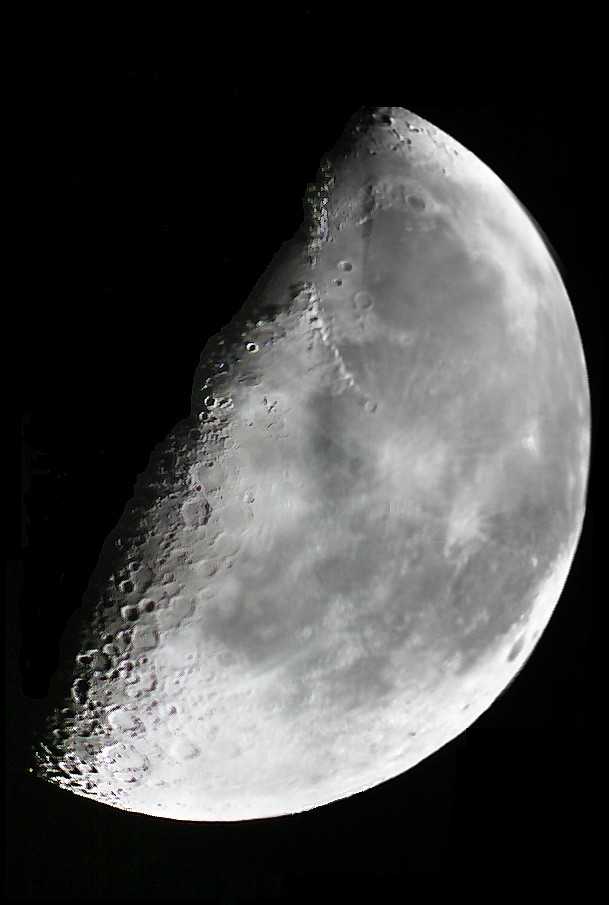Last updated: 16 August 2004
|
Last updated: 16 August 2004 |
This page documents Lunar Planetary Camera comments, tips, and photos. Contributions welcome.
Subject: The chip In the Anttlers Optics Lunar Planetary Camera Sent: Thursday, August 12, 2004 20:07:42 From: Dewain (dbelgard@bellsouth.net) In the notes to the Lunar mosaic I sent you made with my ETX 90 RA and the Anttlers Optics LPC I mentioned the "ccd" of the camera. That was an error. The camera uses an ICM532 CMOS chip. This little CMOS has about the same sensitivity as the Sony ACX098 CCD used in the Phillips ToUCam. I also mentioned that I suspected the Anttlers Optics camera was essentially the same as the Meade LPI, but I haven't been able to find out what chip the Meade LPI uses. Would be happy to know if someone has that information. Thanks, Dewain
Subject: ETX 90 Lunar Mosaic Sent: Monday, August 9, 2004 15:24:51 From: Dewain (dbelgard@bellsouth.net) The images for the attached Lunar mosaic were taken with my ETX 90 RA and the Lunar Planetary Camera (LPC) sold by Anttlers Optics (www.geckooptical.com/anttlers_optics/telescope_acc.html) mounted with a homemade reducer in the eyepiece holder of my ETX . I removed the ETX RA from its original mount (which I sold on eBay) and mounted it using a Baader Planetarium bracket on a Tasco/Celestron Skyguide (GT60) GoTo mount. I also installed a Scopetronix visual back so I can find and frame a shot visually before flipping the mirror to the camera. I've learned just how many turns of the focus shaft will be required then to bring the camera to focus. I made the reducer from the objective achromat in the Meade 21 mm finder that comes on the ETX I replaced this finder with the right angle 25mm model. I mounted the achromat in a shorty Barlow barrel using the thread in cell that originally contained the Barlow lens I think this Barlow was from Scopetronix. I had to shorten the barrel of the Barlow about a quarter inch (using a good quality tube cutter).in order to reach focus, Otherwise I would run out of in-travel before reaching focus with the imager. I estimate from photos of a ruler I took that the LPC functions at about the magnification factor of a 4mm eyepiece without the reducer lens. But with the reducer, it functions about like an 7.5 mm eyepiece. I think that means the reducer makes the ETX function like an f/7 scope (approximately) rather than f/13.5. The amount of reduction varies of course with the distance between the reducer and the camera's little ccd. The more you can increase the distance the wider the field of view and lower the magnification both good things for lunar imaging. I let the moon drift across the camera field of view and shot avi movies in this way in overlapping bands to be sure I covered the entire lunar surface. I used iMerge (http://www.geocities.com/jgroveuk/iMerge.html ) to extract the frames I needed from the avi's, align and stack the images (about a dozen of them) into the mosaic. I also used Registax to align and stack some of the frames.( http://aberrator.astronomy.net/registax/ ) before importing them into iMerge. I darkened a copy of the final mosaic to bring out the detail better in some of the over-exposed areas near the limb. This of course caused a loss of detail in the under-exposed areas near the terminator. But I cut the darkened areas near the limb out of the copy and then used iMerge to align and stack these back onto the original which was balanced to optimize the terminator region. That way I got a better balance in both under-exposed and over-exposed areas. The LPC looks just like the Meade Lunar Planetary Imager. My guess is it IS the same imager, just sold under a different brand name and a cheaper price. Anyway this mosaic was done from light-polluted urban skies in New Orleans. And while it doesn't compare well to mosaics done with larger apertures and expensive CCD equipment. I think it shows the remarkable capabilities of the ETX 90. I think someone with more experience could do much better than this using exactly the same equipment and software I used. Thanks, Dewain Belgard

Return to the top of this page.
Go back to the Astrophotography Page.
Go back to my ETX Home Page.